Entrepreneurship & Small Business: Economic Impact & Venture Types
VerifiedAdded on 2021/04/23
|19
|4821
|28
Report
AI Summary
This report provides a comprehensive overview of entrepreneurship and small business management, beginning with an identification of different types of entrepreneurial organizations, including growth and lifestyle firms. It assesses the overall contribution of these organizations to the national, regional, and local economy of the UK. The report details the key characteristics and skills of an entrepreneur, and identifies the impacts of personal background, economic conditions, and cultural differences on the development of entrepreneurial ventures. It also highlights the role of creativity, innovation, and intellectual property rights in fostering successful small businesses and discusses the significance of SMEs in employment, turnover, and economic growth within various sectors of the UK economy. The report concludes by emphasizing the crucial role of SMEs in driving the social economy and contributing to sustainable development.

Entrepreneurship and small business management
Paraphrase This Document
Need a fresh take? Get an instant paraphrase of this document with our AI Paraphraser
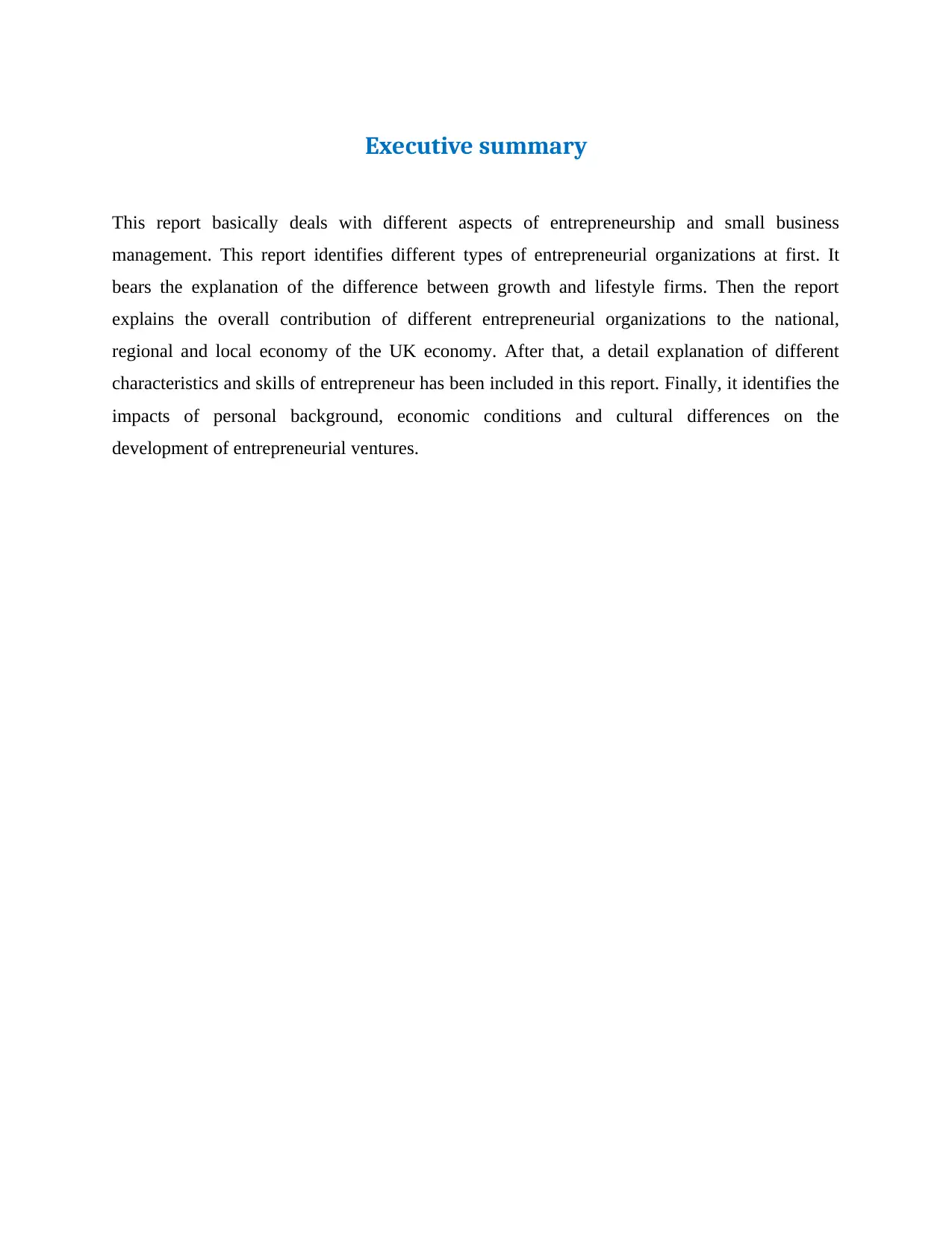
Executive summary
This report basically deals with different aspects of entrepreneurship and small business
management. This report identifies different types of entrepreneurial organizations at first. It
bears the explanation of the difference between growth and lifestyle firms. Then the report
explains the overall contribution of different entrepreneurial organizations to the national,
regional and local economy of the UK economy. After that, a detail explanation of different
characteristics and skills of entrepreneur has been included in this report. Finally, it identifies the
impacts of personal background, economic conditions and cultural differences on the
development of entrepreneurial ventures.
This report basically deals with different aspects of entrepreneurship and small business
management. This report identifies different types of entrepreneurial organizations at first. It
bears the explanation of the difference between growth and lifestyle firms. Then the report
explains the overall contribution of different entrepreneurial organizations to the national,
regional and local economy of the UK economy. After that, a detail explanation of different
characteristics and skills of entrepreneur has been included in this report. Finally, it identifies the
impacts of personal background, economic conditions and cultural differences on the
development of entrepreneurial ventures.

Contents
Executive summary.........................................................................................................................2
Introduction......................................................................................................................................1
LO1: Exploration and illustration different types of ventures that can be considered as
entrepreneurial.................................................................................................................................2
LO-2: The assessment of the impacts of small business organization on the economy..................4
LO-3: Determination and assessment of the key characteristics of an entrepreneur.......................7
LO-4: Different environmental factors that hinder or foster entrepreneurial activities.................10
Conclusion.....................................................................................................................................11
References......................................................................................................................................12
Executive summary.........................................................................................................................2
Introduction......................................................................................................................................1
LO1: Exploration and illustration different types of ventures that can be considered as
entrepreneurial.................................................................................................................................2
LO-2: The assessment of the impacts of small business organization on the economy..................4
LO-3: Determination and assessment of the key characteristics of an entrepreneur.......................7
LO-4: Different environmental factors that hinder or foster entrepreneurial activities.................10
Conclusion.....................................................................................................................................11
References......................................................................................................................................12
⊘ This is a preview!⊘
Do you want full access?
Subscribe today to unlock all pages.

Trusted by 1+ million students worldwide
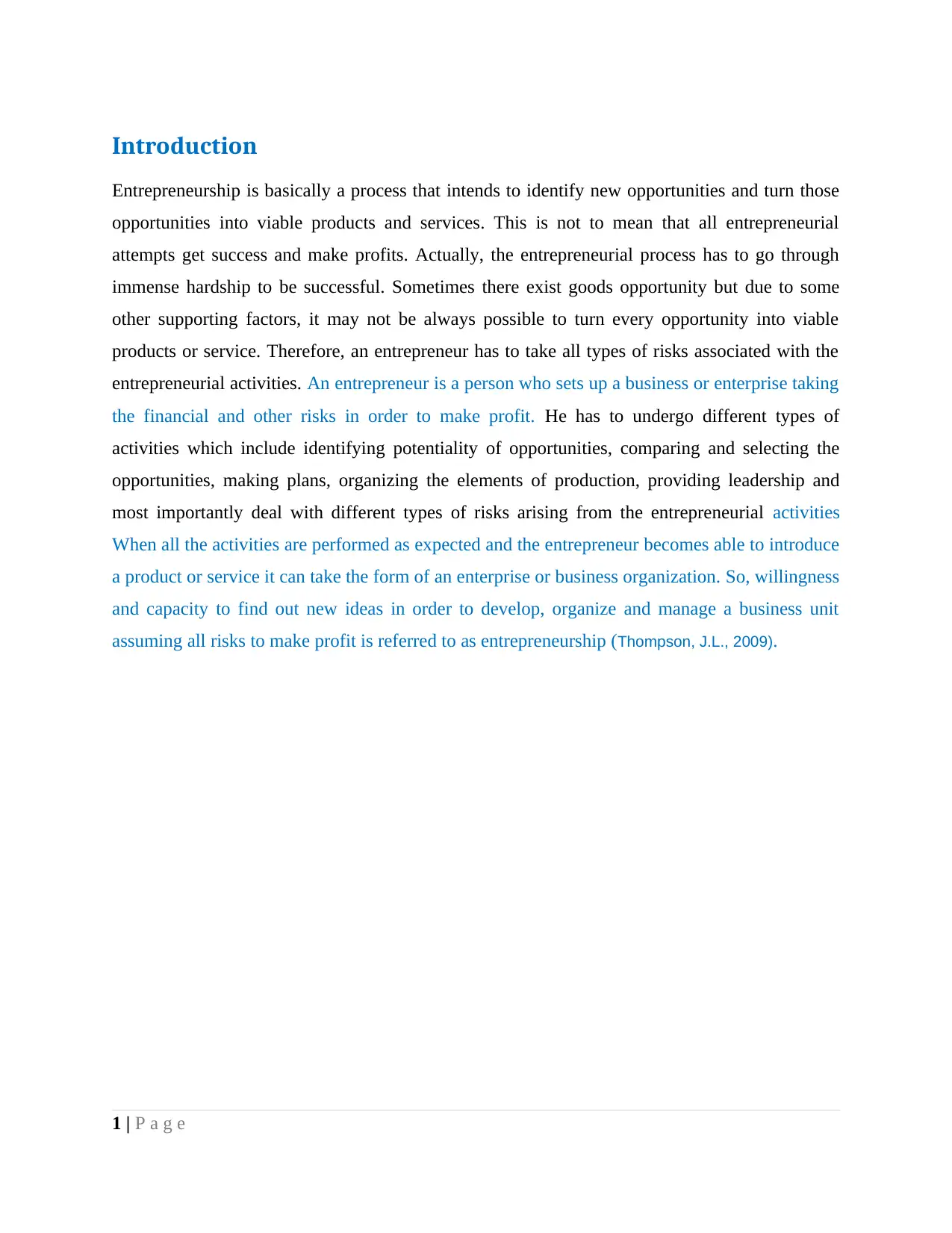
Introduction
Entrepreneurship is basically a process that intends to identify new opportunities and turn those
opportunities into viable products and services. This is not to mean that all entrepreneurial
attempts get success and make profits. Actually, the entrepreneurial process has to go through
immense hardship to be successful. Sometimes there exist goods opportunity but due to some
other supporting factors, it may not be always possible to turn every opportunity into viable
products or service. Therefore, an entrepreneur has to take all types of risks associated with the
entrepreneurial activities. An entrepreneur is a person who sets up a business or enterprise taking
the financial and other risks in order to make profit. He has to undergo different types of
activities which include identifying potentiality of opportunities, comparing and selecting the
opportunities, making plans, organizing the elements of production, providing leadership and
most importantly deal with different types of risks arising from the entrepreneurial activities
When all the activities are performed as expected and the entrepreneur becomes able to introduce
a product or service it can take the form of an enterprise or business organization. So, willingness
and capacity to find out new ideas in order to develop, organize and manage a business unit
assuming all risks to make profit is referred to as entrepreneurship (Thompson, J.L., 2009).
1 | P a g e
Entrepreneurship is basically a process that intends to identify new opportunities and turn those
opportunities into viable products and services. This is not to mean that all entrepreneurial
attempts get success and make profits. Actually, the entrepreneurial process has to go through
immense hardship to be successful. Sometimes there exist goods opportunity but due to some
other supporting factors, it may not be always possible to turn every opportunity into viable
products or service. Therefore, an entrepreneur has to take all types of risks associated with the
entrepreneurial activities. An entrepreneur is a person who sets up a business or enterprise taking
the financial and other risks in order to make profit. He has to undergo different types of
activities which include identifying potentiality of opportunities, comparing and selecting the
opportunities, making plans, organizing the elements of production, providing leadership and
most importantly deal with different types of risks arising from the entrepreneurial activities
When all the activities are performed as expected and the entrepreneur becomes able to introduce
a product or service it can take the form of an enterprise or business organization. So, willingness
and capacity to find out new ideas in order to develop, organize and manage a business unit
assuming all risks to make profit is referred to as entrepreneurship (Thompson, J.L., 2009).
1 | P a g e
Paraphrase This Document
Need a fresh take? Get an instant paraphrase of this document with our AI Paraphraser
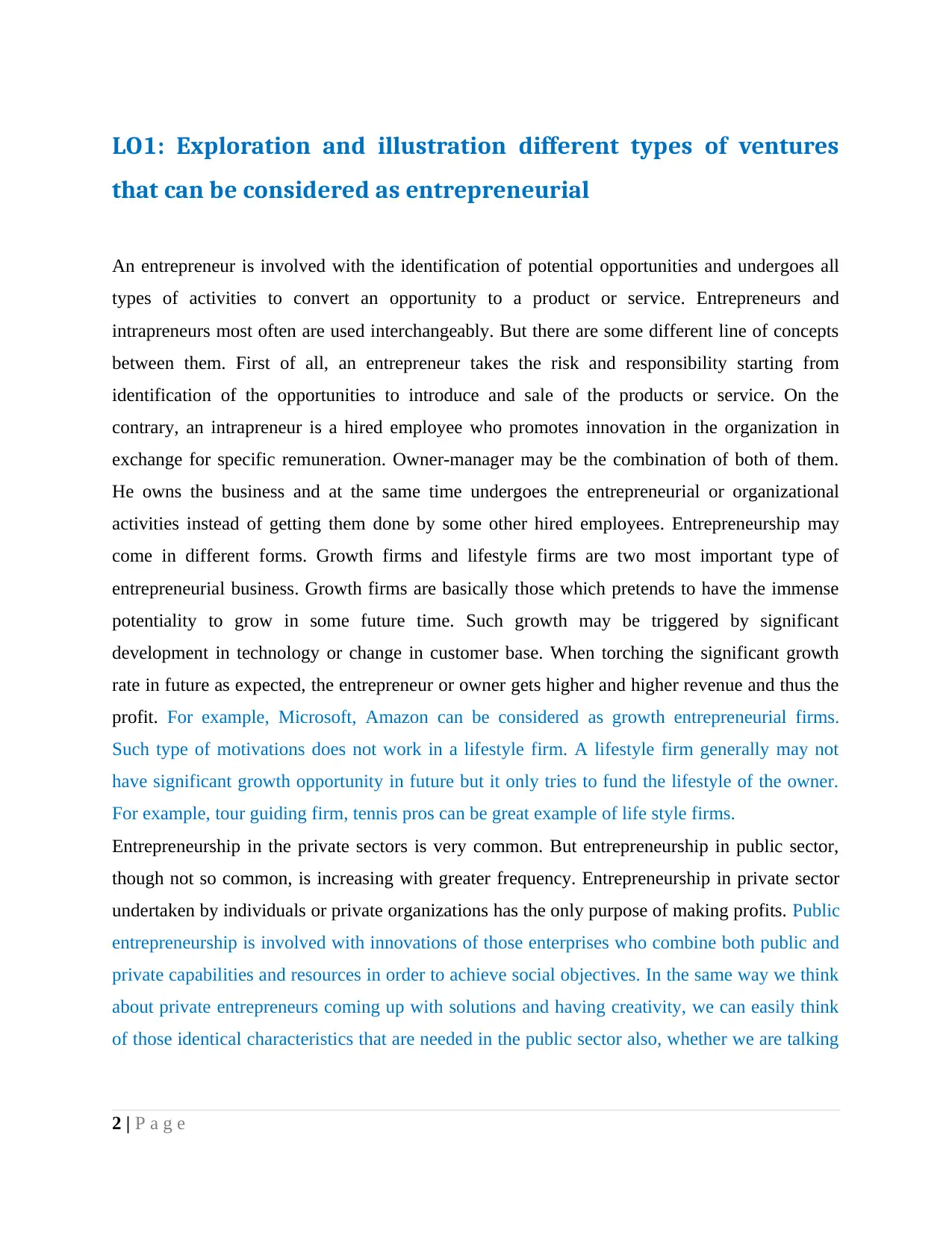
LO1: Exploration and illustration different types of ventures
that can be considered as entrepreneurial
An entrepreneur is involved with the identification of potential opportunities and undergoes all
types of activities to convert an opportunity to a product or service. Entrepreneurs and
intrapreneurs most often are used interchangeably. But there are some different line of concepts
between them. First of all, an entrepreneur takes the risk and responsibility starting from
identification of the opportunities to introduce and sale of the products or service. On the
contrary, an intrapreneur is a hired employee who promotes innovation in the organization in
exchange for specific remuneration. Owner-manager may be the combination of both of them.
He owns the business and at the same time undergoes the entrepreneurial or organizational
activities instead of getting them done by some other hired employees. Entrepreneurship may
come in different forms. Growth firms and lifestyle firms are two most important type of
entrepreneurial business. Growth firms are basically those which pretends to have the immense
potentiality to grow in some future time. Such growth may be triggered by significant
development in technology or change in customer base. When torching the significant growth
rate in future as expected, the entrepreneur or owner gets higher and higher revenue and thus the
profit. For example, Microsoft, Amazon can be considered as growth entrepreneurial firms.
Such type of motivations does not work in a lifestyle firm. A lifestyle firm generally may not
have significant growth opportunity in future but it only tries to fund the lifestyle of the owner.
For example, tour guiding firm, tennis pros can be great example of life style firms.
Entrepreneurship in the private sectors is very common. But entrepreneurship in public sector,
though not so common, is increasing with greater frequency. Entrepreneurship in private sector
undertaken by individuals or private organizations has the only purpose of making profits. Public
entrepreneurship is involved with innovations of those enterprises who combine both public and
private capabilities and resources in order to achieve social objectives. In the same way we think
about private entrepreneurs coming up with solutions and having creativity, we can easily think
of those identical characteristics that are needed in the public sector also, whether we are talking
2 | P a g e
that can be considered as entrepreneurial
An entrepreneur is involved with the identification of potential opportunities and undergoes all
types of activities to convert an opportunity to a product or service. Entrepreneurs and
intrapreneurs most often are used interchangeably. But there are some different line of concepts
between them. First of all, an entrepreneur takes the risk and responsibility starting from
identification of the opportunities to introduce and sale of the products or service. On the
contrary, an intrapreneur is a hired employee who promotes innovation in the organization in
exchange for specific remuneration. Owner-manager may be the combination of both of them.
He owns the business and at the same time undergoes the entrepreneurial or organizational
activities instead of getting them done by some other hired employees. Entrepreneurship may
come in different forms. Growth firms and lifestyle firms are two most important type of
entrepreneurial business. Growth firms are basically those which pretends to have the immense
potentiality to grow in some future time. Such growth may be triggered by significant
development in technology or change in customer base. When torching the significant growth
rate in future as expected, the entrepreneur or owner gets higher and higher revenue and thus the
profit. For example, Microsoft, Amazon can be considered as growth entrepreneurial firms.
Such type of motivations does not work in a lifestyle firm. A lifestyle firm generally may not
have significant growth opportunity in future but it only tries to fund the lifestyle of the owner.
For example, tour guiding firm, tennis pros can be great example of life style firms.
Entrepreneurship in the private sectors is very common. But entrepreneurship in public sector,
though not so common, is increasing with greater frequency. Entrepreneurship in private sector
undertaken by individuals or private organizations has the only purpose of making profits. Public
entrepreneurship is involved with innovations of those enterprises who combine both public and
private capabilities and resources in order to achieve social objectives. In the same way we think
about private entrepreneurs coming up with solutions and having creativity, we can easily think
of those identical characteristics that are needed in the public sector also, whether we are talking
2 | P a g e
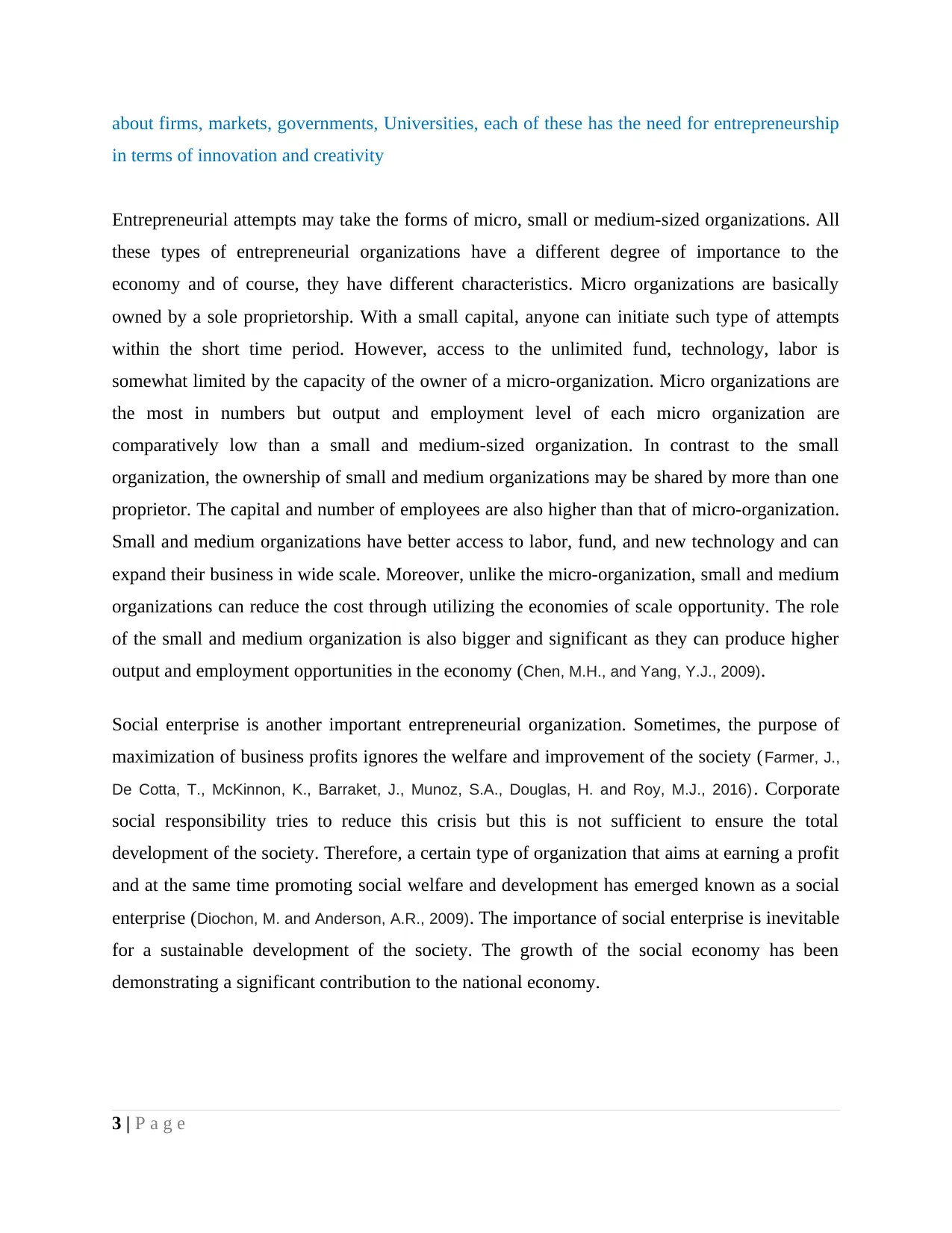
about firms, markets, governments, Universities, each of these has the need for entrepreneurship
in terms of innovation and creativity
Entrepreneurial attempts may take the forms of micro, small or medium-sized organizations. All
these types of entrepreneurial organizations have a different degree of importance to the
economy and of course, they have different characteristics. Micro organizations are basically
owned by a sole proprietorship. With a small capital, anyone can initiate such type of attempts
within the short time period. However, access to the unlimited fund, technology, labor is
somewhat limited by the capacity of the owner of a micro-organization. Micro organizations are
the most in numbers but output and employment level of each micro organization are
comparatively low than a small and medium-sized organization. In contrast to the small
organization, the ownership of small and medium organizations may be shared by more than one
proprietor. The capital and number of employees are also higher than that of micro-organization.
Small and medium organizations have better access to labor, fund, and new technology and can
expand their business in wide scale. Moreover, unlike the micro-organization, small and medium
organizations can reduce the cost through utilizing the economies of scale opportunity. The role
of the small and medium organization is also bigger and significant as they can produce higher
output and employment opportunities in the economy (Chen, M.H., and Yang, Y.J., 2009).
Social enterprise is another important entrepreneurial organization. Sometimes, the purpose of
maximization of business profits ignores the welfare and improvement of the society (Farmer, J.,
De Cotta, T., McKinnon, K., Barraket, J., Munoz, S.A., Douglas, H. and Roy, M.J., 2016). Corporate
social responsibility tries to reduce this crisis but this is not sufficient to ensure the total
development of the society. Therefore, a certain type of organization that aims at earning a profit
and at the same time promoting social welfare and development has emerged known as a social
enterprise (Diochon, M. and Anderson, A.R., 2009). The importance of social enterprise is inevitable
for a sustainable development of the society. The growth of the social economy has been
demonstrating a significant contribution to the national economy.
3 | P a g e
in terms of innovation and creativity
Entrepreneurial attempts may take the forms of micro, small or medium-sized organizations. All
these types of entrepreneurial organizations have a different degree of importance to the
economy and of course, they have different characteristics. Micro organizations are basically
owned by a sole proprietorship. With a small capital, anyone can initiate such type of attempts
within the short time period. However, access to the unlimited fund, technology, labor is
somewhat limited by the capacity of the owner of a micro-organization. Micro organizations are
the most in numbers but output and employment level of each micro organization are
comparatively low than a small and medium-sized organization. In contrast to the small
organization, the ownership of small and medium organizations may be shared by more than one
proprietor. The capital and number of employees are also higher than that of micro-organization.
Small and medium organizations have better access to labor, fund, and new technology and can
expand their business in wide scale. Moreover, unlike the micro-organization, small and medium
organizations can reduce the cost through utilizing the economies of scale opportunity. The role
of the small and medium organization is also bigger and significant as they can produce higher
output and employment opportunities in the economy (Chen, M.H., and Yang, Y.J., 2009).
Social enterprise is another important entrepreneurial organization. Sometimes, the purpose of
maximization of business profits ignores the welfare and improvement of the society (Farmer, J.,
De Cotta, T., McKinnon, K., Barraket, J., Munoz, S.A., Douglas, H. and Roy, M.J., 2016). Corporate
social responsibility tries to reduce this crisis but this is not sufficient to ensure the total
development of the society. Therefore, a certain type of organization that aims at earning a profit
and at the same time promoting social welfare and development has emerged known as a social
enterprise (Diochon, M. and Anderson, A.R., 2009). The importance of social enterprise is inevitable
for a sustainable development of the society. The growth of the social economy has been
demonstrating a significant contribution to the national economy.
3 | P a g e
⊘ This is a preview!⊘
Do you want full access?
Subscribe today to unlock all pages.

Trusted by 1+ million students worldwide
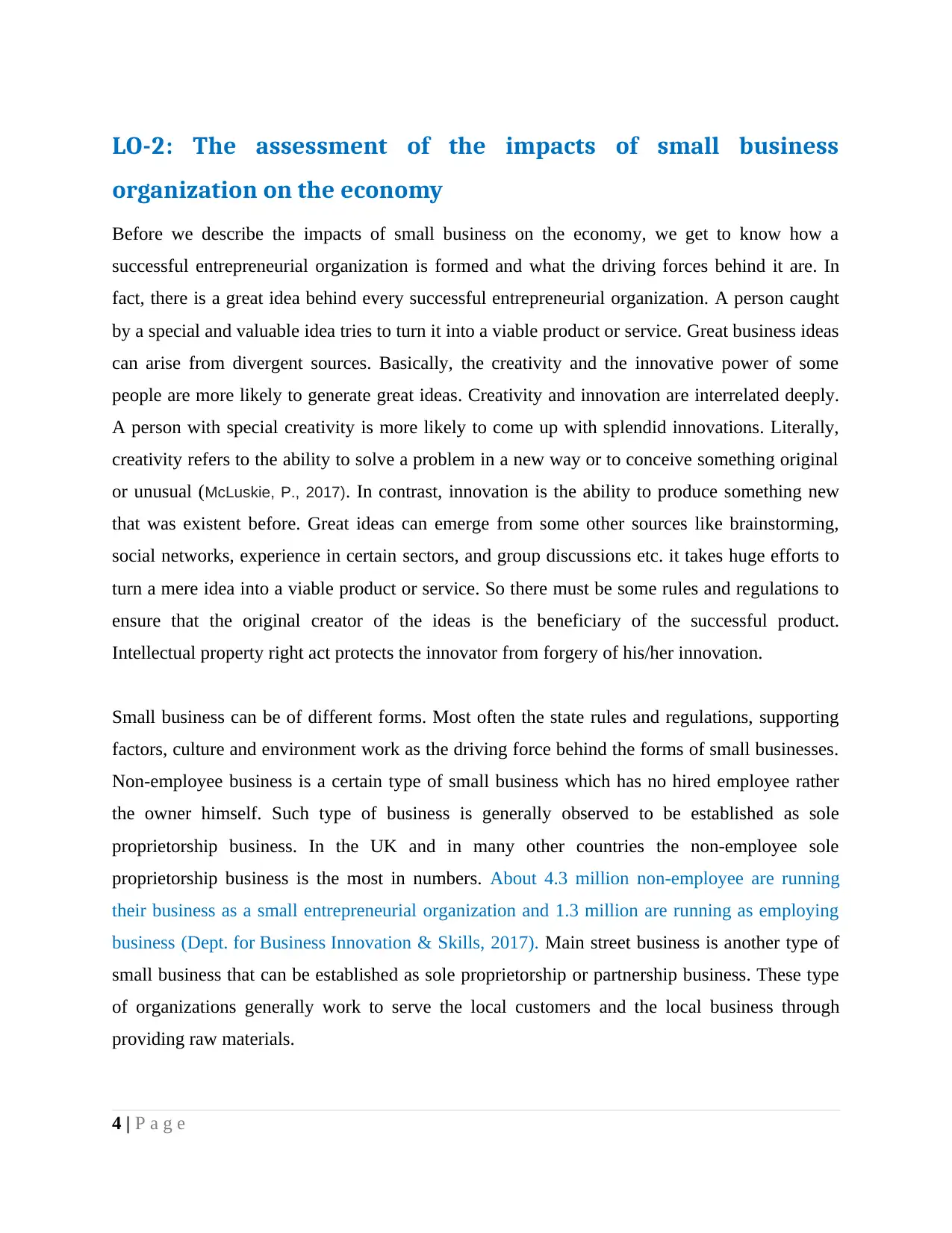
LO-2: The assessment of the impacts of small business
organization on the economy
Before we describe the impacts of small business on the economy, we get to know how a
successful entrepreneurial organization is formed and what the driving forces behind it are. In
fact, there is a great idea behind every successful entrepreneurial organization. A person caught
by a special and valuable idea tries to turn it into a viable product or service. Great business ideas
can arise from divergent sources. Basically, the creativity and the innovative power of some
people are more likely to generate great ideas. Creativity and innovation are interrelated deeply.
A person with special creativity is more likely to come up with splendid innovations. Literally,
creativity refers to the ability to solve a problem in a new way or to conceive something original
or unusual (McLuskie, P., 2017). In contrast, innovation is the ability to produce something new
that was existent before. Great ideas can emerge from some other sources like brainstorming,
social networks, experience in certain sectors, and group discussions etc. it takes huge efforts to
turn a mere idea into a viable product or service. So there must be some rules and regulations to
ensure that the original creator of the ideas is the beneficiary of the successful product.
Intellectual property right act protects the innovator from forgery of his/her innovation.
Small business can be of different forms. Most often the state rules and regulations, supporting
factors, culture and environment work as the driving force behind the forms of small businesses.
Non-employee business is a certain type of small business which has no hired employee rather
the owner himself. Such type of business is generally observed to be established as sole
proprietorship business. In the UK and in many other countries the non-employee sole
proprietorship business is the most in numbers. About 4.3 million non-employee are running
their business as a small entrepreneurial organization and 1.3 million are running as employing
business (Dept. for Business Innovation & Skills, 2017). Main street business is another type of
small business that can be established as sole proprietorship or partnership business. These type
of organizations generally work to serve the local customers and the local business through
providing raw materials.
4 | P a g e
organization on the economy
Before we describe the impacts of small business on the economy, we get to know how a
successful entrepreneurial organization is formed and what the driving forces behind it are. In
fact, there is a great idea behind every successful entrepreneurial organization. A person caught
by a special and valuable idea tries to turn it into a viable product or service. Great business ideas
can arise from divergent sources. Basically, the creativity and the innovative power of some
people are more likely to generate great ideas. Creativity and innovation are interrelated deeply.
A person with special creativity is more likely to come up with splendid innovations. Literally,
creativity refers to the ability to solve a problem in a new way or to conceive something original
or unusual (McLuskie, P., 2017). In contrast, innovation is the ability to produce something new
that was existent before. Great ideas can emerge from some other sources like brainstorming,
social networks, experience in certain sectors, and group discussions etc. it takes huge efforts to
turn a mere idea into a viable product or service. So there must be some rules and regulations to
ensure that the original creator of the ideas is the beneficiary of the successful product.
Intellectual property right act protects the innovator from forgery of his/her innovation.
Small business can be of different forms. Most often the state rules and regulations, supporting
factors, culture and environment work as the driving force behind the forms of small businesses.
Non-employee business is a certain type of small business which has no hired employee rather
the owner himself. Such type of business is generally observed to be established as sole
proprietorship business. In the UK and in many other countries the non-employee sole
proprietorship business is the most in numbers. About 4.3 million non-employee are running
their business as a small entrepreneurial organization and 1.3 million are running as employing
business (Dept. for Business Innovation & Skills, 2017). Main street business is another type of
small business that can be established as sole proprietorship or partnership business. These type
of organizations generally work to serve the local customers and the local business through
providing raw materials.
4 | P a g e
Paraphrase This Document
Need a fresh take? Get an instant paraphrase of this document with our AI Paraphraser
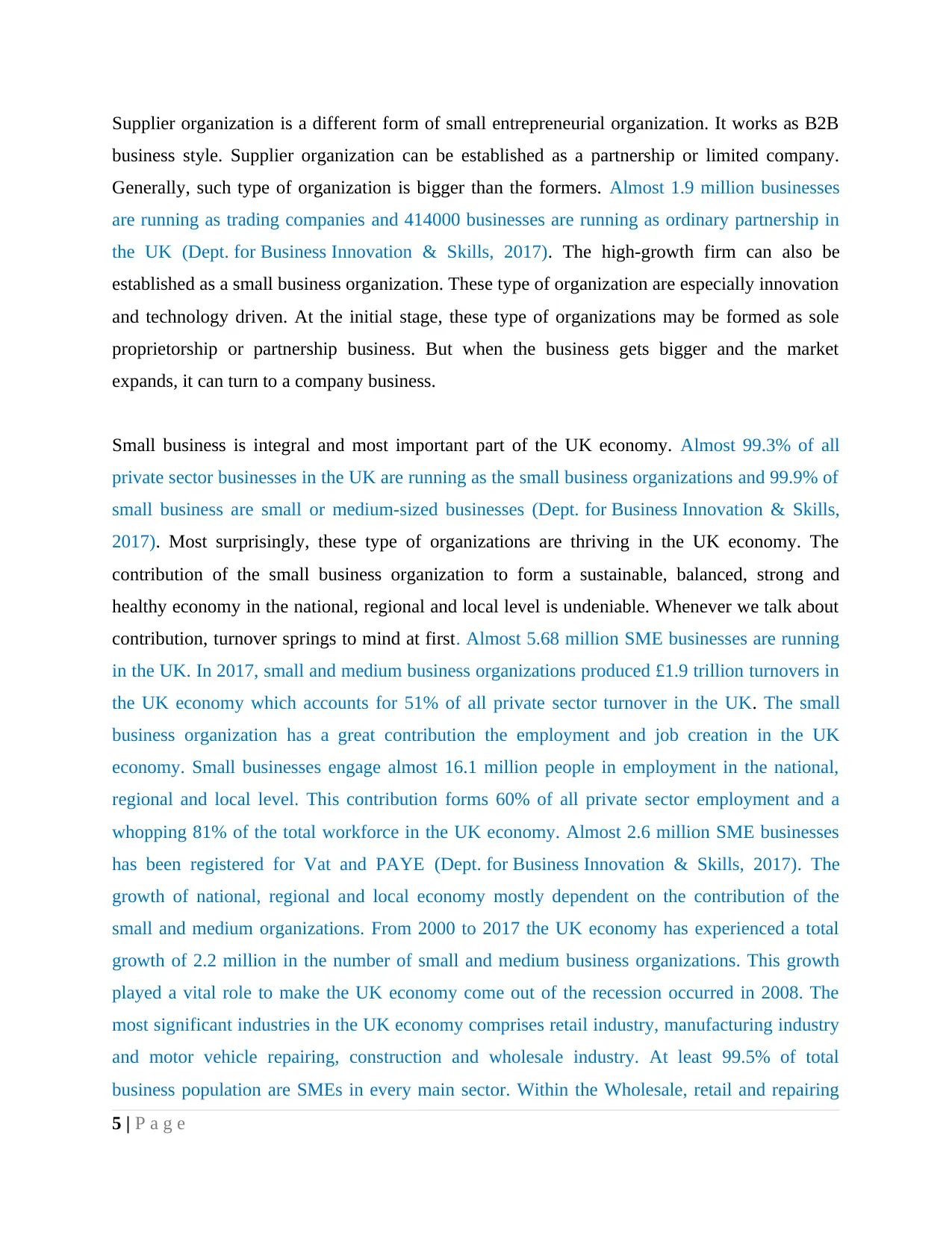
Supplier organization is a different form of small entrepreneurial organization. It works as B2B
business style. Supplier organization can be established as a partnership or limited company.
Generally, such type of organization is bigger than the formers. Almost 1.9 million businesses
are running as trading companies and 414000 businesses are running as ordinary partnership in
the UK (Dept. for Business Innovation & Skills, 2017). The high-growth firm can also be
established as a small business organization. These type of organization are especially innovation
and technology driven. At the initial stage, these type of organizations may be formed as sole
proprietorship or partnership business. But when the business gets bigger and the market
expands, it can turn to a company business.
Small business is integral and most important part of the UK economy. Almost 99.3% of all
private sector businesses in the UK are running as the small business organizations and 99.9% of
small business are small or medium-sized businesses (Dept. for Business Innovation & Skills,
2017). Most surprisingly, these type of organizations are thriving in the UK economy. The
contribution of the small business organization to form a sustainable, balanced, strong and
healthy economy in the national, regional and local level is undeniable. Whenever we talk about
contribution, turnover springs to mind at first. Almost 5.68 million SME businesses are running
in the UK. In 2017, small and medium business organizations produced £1.9 trillion turnovers in
the UK economy which accounts for 51% of all private sector turnover in the UK. The small
business organization has a great contribution the employment and job creation in the UK
economy. Small businesses engage almost 16.1 million people in employment in the national,
regional and local level. This contribution forms 60% of all private sector employment and a
whopping 81% of the total workforce in the UK economy. Almost 2.6 million SME businesses
has been registered for Vat and PAYE (Dept. for Business Innovation & Skills, 2017). The
growth of national, regional and local economy mostly dependent on the contribution of the
small and medium organizations. From 2000 to 2017 the UK economy has experienced a total
growth of 2.2 million in the number of small and medium business organizations. This growth
played a vital role to make the UK economy come out of the recession occurred in 2008. The
most significant industries in the UK economy comprises retail industry, manufacturing industry
and motor vehicle repairing, construction and wholesale industry. At least 99.5% of total
business population are SMEs in every main sector. Within the Wholesale, retail and repairing
5 | P a g e
business style. Supplier organization can be established as a partnership or limited company.
Generally, such type of organization is bigger than the formers. Almost 1.9 million businesses
are running as trading companies and 414000 businesses are running as ordinary partnership in
the UK (Dept. for Business Innovation & Skills, 2017). The high-growth firm can also be
established as a small business organization. These type of organization are especially innovation
and technology driven. At the initial stage, these type of organizations may be formed as sole
proprietorship or partnership business. But when the business gets bigger and the market
expands, it can turn to a company business.
Small business is integral and most important part of the UK economy. Almost 99.3% of all
private sector businesses in the UK are running as the small business organizations and 99.9% of
small business are small or medium-sized businesses (Dept. for Business Innovation & Skills,
2017). Most surprisingly, these type of organizations are thriving in the UK economy. The
contribution of the small business organization to form a sustainable, balanced, strong and
healthy economy in the national, regional and local level is undeniable. Whenever we talk about
contribution, turnover springs to mind at first. Almost 5.68 million SME businesses are running
in the UK. In 2017, small and medium business organizations produced £1.9 trillion turnovers in
the UK economy which accounts for 51% of all private sector turnover in the UK. The small
business organization has a great contribution the employment and job creation in the UK
economy. Small businesses engage almost 16.1 million people in employment in the national,
regional and local level. This contribution forms 60% of all private sector employment and a
whopping 81% of the total workforce in the UK economy. Almost 2.6 million SME businesses
has been registered for Vat and PAYE (Dept. for Business Innovation & Skills, 2017). The
growth of national, regional and local economy mostly dependent on the contribution of the
small and medium organizations. From 2000 to 2017 the UK economy has experienced a total
growth of 2.2 million in the number of small and medium business organizations. This growth
played a vital role to make the UK economy come out of the recession occurred in 2008. The
most significant industries in the UK economy comprises retail industry, manufacturing industry
and motor vehicle repairing, construction and wholesale industry. At least 99.5% of total
business population are SMEs in every main sector. Within the Wholesale, retail and repairing
5 | P a g e

industry about 14% businesses are established as SME enterprise. Construction industry includes
12% SME enterprises and manufacturing industry includes 10% SME enterprises. There are
almost 34000 SMEs in mining, quarrying and utilities industry. Moreover, 855000 SMEs are
operating in the professional, scientific and technical activities (Dept. for Business Innovation &
Skills, 2017). That is the testimony how essential are the small businesses in the national,
regional and local economy of the UK. SMEs have huge contribution to the growth of social
economy also. Social economy comprises of various types of organizations and enterprises like
cooperatives, mutual, associations, foundations etc. These organizations can be established both
as SME or large organizations. Social economy develops to find out solutions for some certain
issues like economic, environmental or social. Sometimes these needs are unsatisfied or
inadequately satisfied by the public or private organizations. SMEs established not-for-profit can
play a vital role to create a strong, prosperous, sustainable and inclusive society. (Williams, C.C.,
2007). SMEs generally contribute to almost 55% of GDP and over 65% of total employment in
high-income countries, and account for 60% of GDP and more than 70% of total employment in
low income countries, while they contribute about 70% of GDP and 95% of total employment in
middle income countries
(Felix Moses Edoho, 2015). Edminston (2007) opines from the viewing platform of economic
development that small businesses generate virtually half of new jobs in the economy, and it is
presumed that they are good jobs. SMEs are the growth engines of the social economy due to
their ability to create jobs, foster entrepreneurship, alleviate poverty, accelerate growth, bridge
the gulf of income inequity and formation of forward and backward linkages and provide depth
to the industrial base of the economy.
6 | P a g e
12% SME enterprises and manufacturing industry includes 10% SME enterprises. There are
almost 34000 SMEs in mining, quarrying and utilities industry. Moreover, 855000 SMEs are
operating in the professional, scientific and technical activities (Dept. for Business Innovation &
Skills, 2017). That is the testimony how essential are the small businesses in the national,
regional and local economy of the UK. SMEs have huge contribution to the growth of social
economy also. Social economy comprises of various types of organizations and enterprises like
cooperatives, mutual, associations, foundations etc. These organizations can be established both
as SME or large organizations. Social economy develops to find out solutions for some certain
issues like economic, environmental or social. Sometimes these needs are unsatisfied or
inadequately satisfied by the public or private organizations. SMEs established not-for-profit can
play a vital role to create a strong, prosperous, sustainable and inclusive society. (Williams, C.C.,
2007). SMEs generally contribute to almost 55% of GDP and over 65% of total employment in
high-income countries, and account for 60% of GDP and more than 70% of total employment in
low income countries, while they contribute about 70% of GDP and 95% of total employment in
middle income countries
(Felix Moses Edoho, 2015). Edminston (2007) opines from the viewing platform of economic
development that small businesses generate virtually half of new jobs in the economy, and it is
presumed that they are good jobs. SMEs are the growth engines of the social economy due to
their ability to create jobs, foster entrepreneurship, alleviate poverty, accelerate growth, bridge
the gulf of income inequity and formation of forward and backward linkages and provide depth
to the industrial base of the economy.
6 | P a g e
⊘ This is a preview!⊘
Do you want full access?
Subscribe today to unlock all pages.

Trusted by 1+ million students worldwide

The trends and prospects of business start-ups are the identicals across the world. Some countries
experience better growth in start-ups and some countries face an obstacle in the way of
developing start-ups. The most significant and influential factor is the cultural differences around
the world. In addition, technological development, the tendency to innovation and creativity,
access to labor, fund, and technology, support of the local and national government are driving
forces towards the promotion and development of new start-ups. Countries which are flexible on
these criteria experience higher growth in the start-ups.
7 | P a g e
experience better growth in start-ups and some countries face an obstacle in the way of
developing start-ups. The most significant and influential factor is the cultural differences around
the world. In addition, technological development, the tendency to innovation and creativity,
access to labor, fund, and technology, support of the local and national government are driving
forces towards the promotion and development of new start-ups. Countries which are flexible on
these criteria experience higher growth in the start-ups.
7 | P a g e
Paraphrase This Document
Need a fresh take? Get an instant paraphrase of this document with our AI Paraphraser
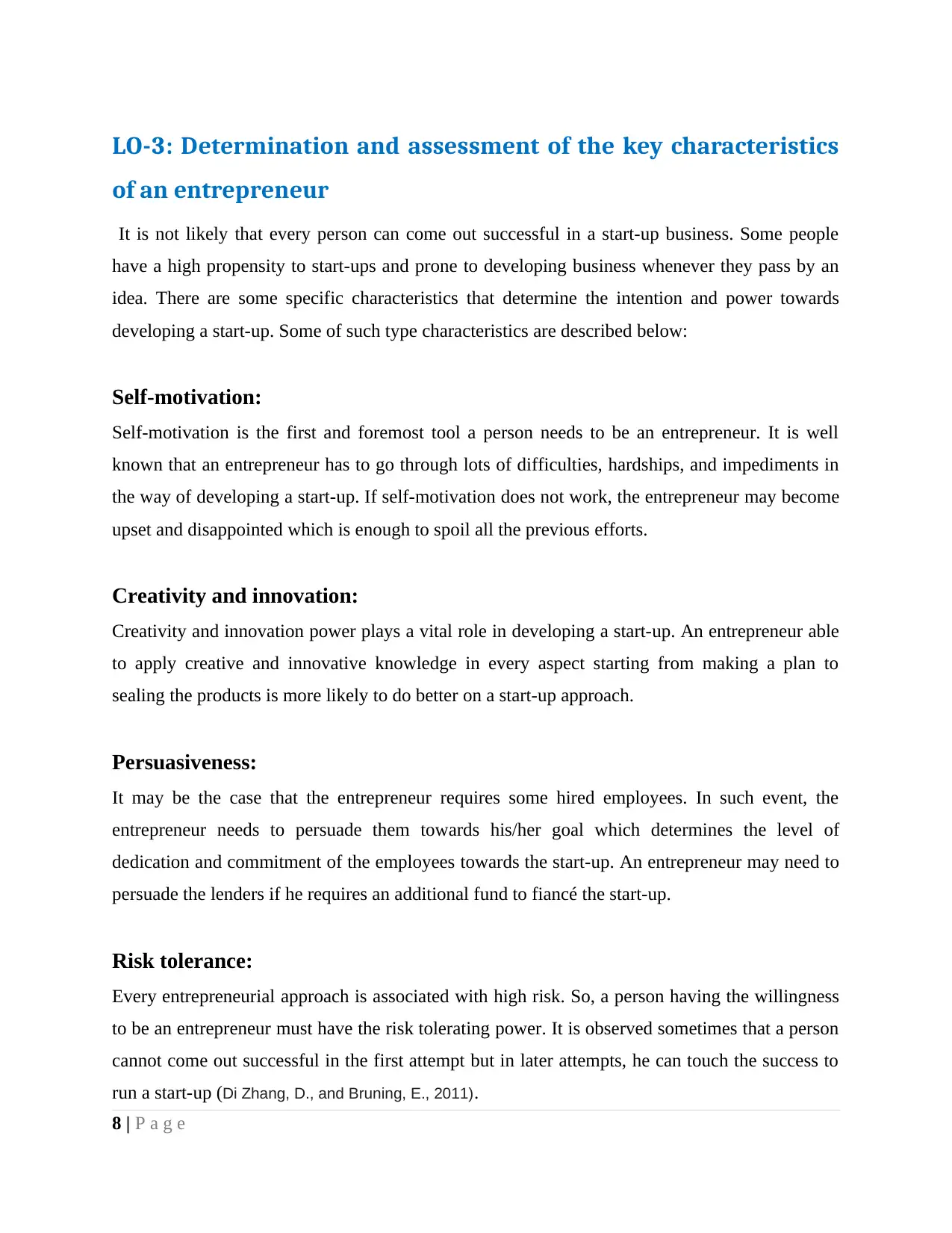
LO-3: Determination and assessment of the key characteristics
of an entrepreneur
It is not likely that every person can come out successful in a start-up business. Some people
have a high propensity to start-ups and prone to developing business whenever they pass by an
idea. There are some specific characteristics that determine the intention and power towards
developing a start-up. Some of such type characteristics are described below:
Self-motivation:
Self-motivation is the first and foremost tool a person needs to be an entrepreneur. It is well
known that an entrepreneur has to go through lots of difficulties, hardships, and impediments in
the way of developing a start-up. If self-motivation does not work, the entrepreneur may become
upset and disappointed which is enough to spoil all the previous efforts.
Creativity and innovation:
Creativity and innovation power plays a vital role in developing a start-up. An entrepreneur able
to apply creative and innovative knowledge in every aspect starting from making a plan to
sealing the products is more likely to do better on a start-up approach.
Persuasiveness:
It may be the case that the entrepreneur requires some hired employees. In such event, the
entrepreneur needs to persuade them towards his/her goal which determines the level of
dedication and commitment of the employees towards the start-up. An entrepreneur may need to
persuade the lenders if he requires an additional fund to fiancé the start-up.
Risk tolerance:
Every entrepreneurial approach is associated with high risk. So, a person having the willingness
to be an entrepreneur must have the risk tolerating power. It is observed sometimes that a person
cannot come out successful in the first attempt but in later attempts, he can touch the success to
run a start-up (Di Zhang, D., and Bruning, E., 2011).
8 | P a g e
of an entrepreneur
It is not likely that every person can come out successful in a start-up business. Some people
have a high propensity to start-ups and prone to developing business whenever they pass by an
idea. There are some specific characteristics that determine the intention and power towards
developing a start-up. Some of such type characteristics are described below:
Self-motivation:
Self-motivation is the first and foremost tool a person needs to be an entrepreneur. It is well
known that an entrepreneur has to go through lots of difficulties, hardships, and impediments in
the way of developing a start-up. If self-motivation does not work, the entrepreneur may become
upset and disappointed which is enough to spoil all the previous efforts.
Creativity and innovation:
Creativity and innovation power plays a vital role in developing a start-up. An entrepreneur able
to apply creative and innovative knowledge in every aspect starting from making a plan to
sealing the products is more likely to do better on a start-up approach.
Persuasiveness:
It may be the case that the entrepreneur requires some hired employees. In such event, the
entrepreneur needs to persuade them towards his/her goal which determines the level of
dedication and commitment of the employees towards the start-up. An entrepreneur may need to
persuade the lenders if he requires an additional fund to fiancé the start-up.
Risk tolerance:
Every entrepreneurial approach is associated with high risk. So, a person having the willingness
to be an entrepreneur must have the risk tolerating power. It is observed sometimes that a person
cannot come out successful in the first attempt but in later attempts, he can touch the success to
run a start-up (Di Zhang, D., and Bruning, E., 2011).
8 | P a g e
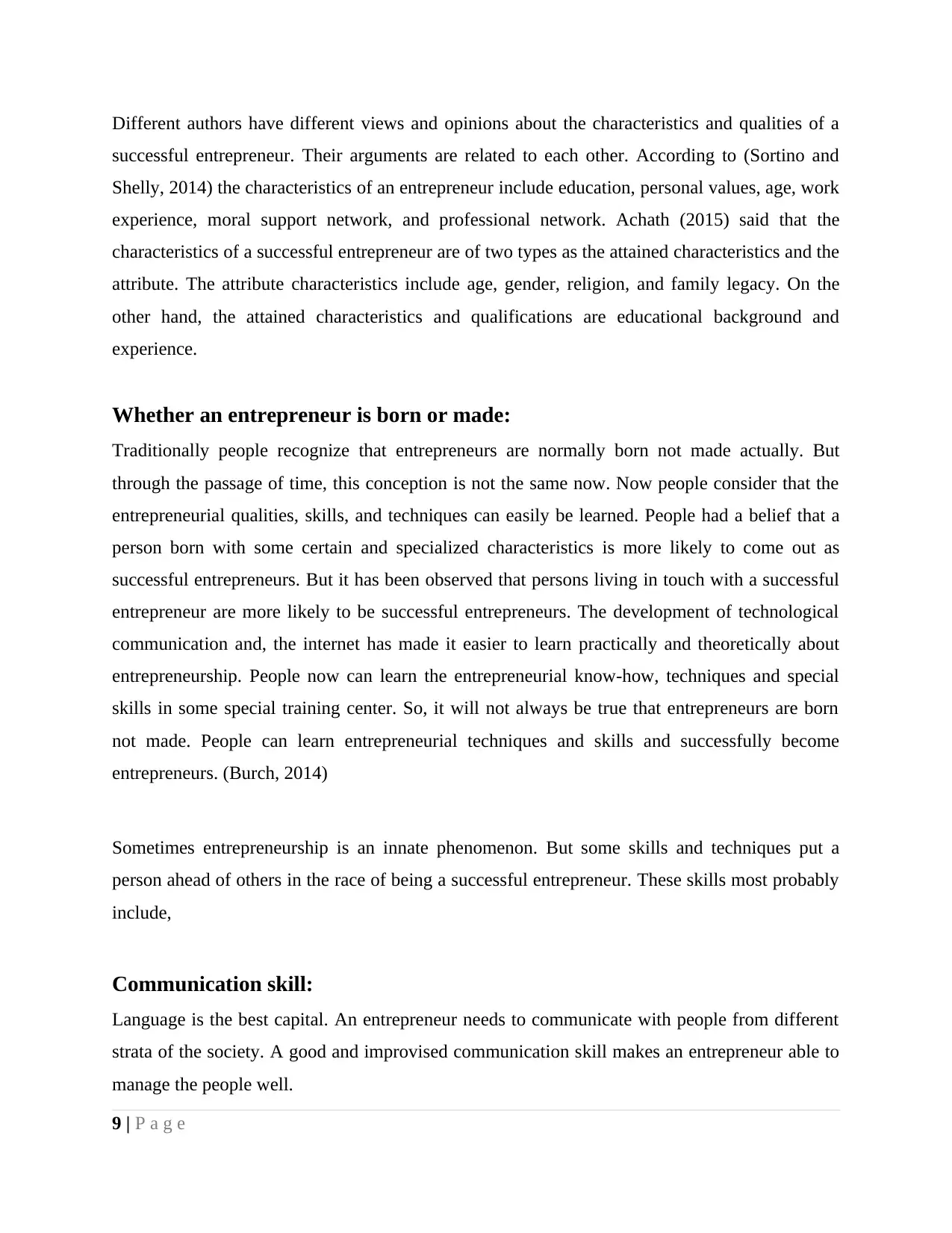
Different authors have different views and opinions about the characteristics and qualities of a
successful entrepreneur. Their arguments are related to each other. According to (Sortino and
Shelly, 2014) the characteristics of an entrepreneur include education, personal values, age, work
experience, moral support network, and professional network. Achath (2015) said that the
characteristics of a successful entrepreneur are of two types as the attained characteristics and the
attribute. The attribute characteristics include age, gender, religion, and family legacy. On the
other hand, the attained characteristics and qualifications are educational background and
experience.
Whether an entrepreneur is born or made:
Traditionally people recognize that entrepreneurs are normally born not made actually. But
through the passage of time, this conception is not the same now. Now people consider that the
entrepreneurial qualities, skills, and techniques can easily be learned. People had a belief that a
person born with some certain and specialized characteristics is more likely to come out as
successful entrepreneurs. But it has been observed that persons living in touch with a successful
entrepreneur are more likely to be successful entrepreneurs. The development of technological
communication and, the internet has made it easier to learn practically and theoretically about
entrepreneurship. People now can learn the entrepreneurial know-how, techniques and special
skills in some special training center. So, it will not always be true that entrepreneurs are born
not made. People can learn entrepreneurial techniques and skills and successfully become
entrepreneurs. (Burch, 2014)
Sometimes entrepreneurship is an innate phenomenon. But some skills and techniques put a
person ahead of others in the race of being a successful entrepreneur. These skills most probably
include,
Communication skill:
Language is the best capital. An entrepreneur needs to communicate with people from different
strata of the society. A good and improvised communication skill makes an entrepreneur able to
manage the people well.
9 | P a g e
successful entrepreneur. Their arguments are related to each other. According to (Sortino and
Shelly, 2014) the characteristics of an entrepreneur include education, personal values, age, work
experience, moral support network, and professional network. Achath (2015) said that the
characteristics of a successful entrepreneur are of two types as the attained characteristics and the
attribute. The attribute characteristics include age, gender, religion, and family legacy. On the
other hand, the attained characteristics and qualifications are educational background and
experience.
Whether an entrepreneur is born or made:
Traditionally people recognize that entrepreneurs are normally born not made actually. But
through the passage of time, this conception is not the same now. Now people consider that the
entrepreneurial qualities, skills, and techniques can easily be learned. People had a belief that a
person born with some certain and specialized characteristics is more likely to come out as
successful entrepreneurs. But it has been observed that persons living in touch with a successful
entrepreneur are more likely to be successful entrepreneurs. The development of technological
communication and, the internet has made it easier to learn practically and theoretically about
entrepreneurship. People now can learn the entrepreneurial know-how, techniques and special
skills in some special training center. So, it will not always be true that entrepreneurs are born
not made. People can learn entrepreneurial techniques and skills and successfully become
entrepreneurs. (Burch, 2014)
Sometimes entrepreneurship is an innate phenomenon. But some skills and techniques put a
person ahead of others in the race of being a successful entrepreneur. These skills most probably
include,
Communication skill:
Language is the best capital. An entrepreneur needs to communicate with people from different
strata of the society. A good and improvised communication skill makes an entrepreneur able to
manage the people well.
9 | P a g e
⊘ This is a preview!⊘
Do you want full access?
Subscribe today to unlock all pages.

Trusted by 1+ million students worldwide
1 out of 19
Related Documents
Your All-in-One AI-Powered Toolkit for Academic Success.
+13062052269
info@desklib.com
Available 24*7 on WhatsApp / Email
![[object Object]](/_next/static/media/star-bottom.7253800d.svg)
Unlock your academic potential
Copyright © 2020–2025 A2Z Services. All Rights Reserved. Developed and managed by ZUCOL.





